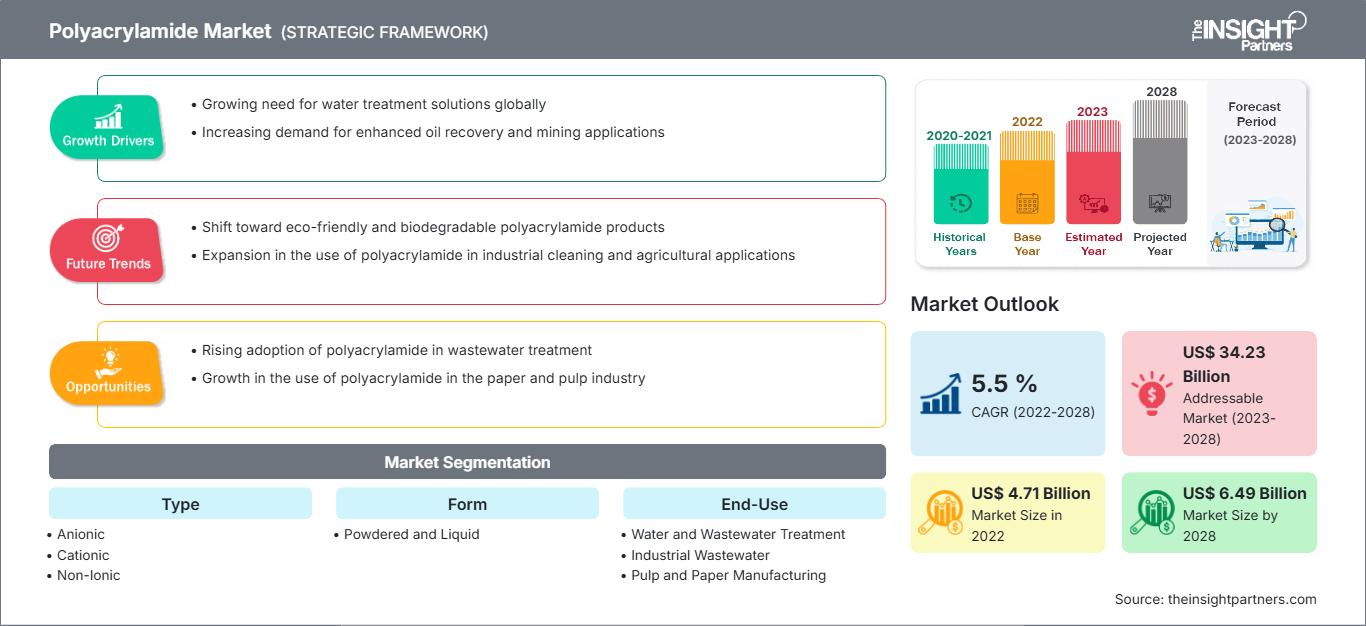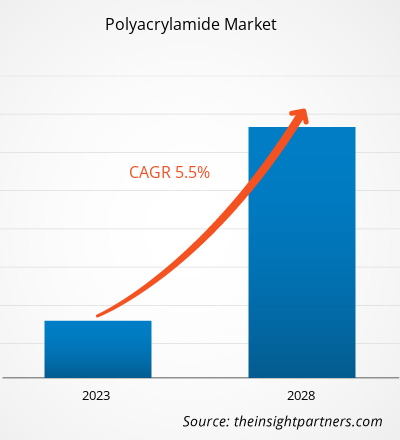[Forschungsbericht]Der Polyacrylamid-Markt wurde im Jahr 2022 auf 4.714,79 Millionen US-Dollar geschätzt und soll bis 2028 voraussichtlich 6.485,30 Millionen US-Dollar erreichen; von 2022 bis 2028 wird eine durchschnittliche jährliche Wachstumsrate (CAGR) von 5,5 % erwartet.
Die weltweit schnell wachsenden Wasseraufbereitungsindustrien werden das Wachstum des Polyacrylamid-Marktes voraussichtlich vorantreiben. Polyacrylamid ist ein synthetisches, langkettiges Homopolymer. Es hat ein hohes Molekulargewicht und eine hohe Wasserlöslichkeit und eignet sich daher gut für die Wasseraufbereitung. Es wird häufig als Verdickungsmittel, Bindemittel und Flockungsmittel verwendet. Investitionen in Energieprojekte aufgrund der steigenden Nachfrage erhöhen auch die Nachfrage nach Polyacrylamid in der Erdölindustrie. Beispielsweise investieren die USA in ihre Schieferöl- und -gasexplorationsprojekte, um die steigende Nachfrage zu decken und die Abhängigkeit von den Ländern des Nahen Ostens bei Öl, Erdöl und petrochemischen Derivaten zu verringern.
Der Markt wird von multinationalen Unternehmen wie der SNF Group, BASF SE und Kemira dominiert, die mehr als 50 % des Gesamtmarktanteils ausmachen. Diese multinationalen Unternehmen verfügen über Systeme, um ihre Produkte direkt oder indirekt auf den nationalen und internationalen Märkten zu vertreiben. Darüber hinaus wird erwartet, dass die Unternehmen ihre Produktion steigern, um die steigende globale Nachfrage zu decken, die auch die Nachfrage nach Polyacrylamid zur Herstellung verschiedener Produkte für die Endverbrauchsindustrie vorweggenommen hat. Wichtige Hersteller wie SNF und BASF SE verfügen über Markenwerte und strategische Partnerschaften, die eine einfache Vermarktung ihrer Polyacrylamidprodukte auf dem Markt ermöglichen. Die Hersteller konzentrieren sich auf die Verbesserung ihrer Produktqualität und investieren mehr in Forschung und Entwicklung, um die Polyacrylamidkosten zu senken und die Verbraucherbasis zu erschließen.
Passen Sie diesen Bericht Ihren Anforderungen an
Sie erhalten kostenlos Anpassungen an jedem Bericht, einschließlich Teilen dieses Berichts oder einer Analyse auf Länderebene, eines Excel-Datenpakets sowie tolle Angebote und Rabatte für Start-ups und Universitäten.
Polyacrylamid-Markt: Strategische Einblicke

- Holen Sie sich die wichtigsten Markttrends aus diesem Bericht.Dieses KOSTENLOSE Beispiel umfasst Datenanalysen, die von Markttrends bis hin zu Schätzungen und Prognosen reichen.
Sie erhalten kostenlos Anpassungen an jedem Bericht, einschließlich Teilen dieses Berichts oder einer Analyse auf Länderebene, eines Excel-Datenpakets sowie tolle Angebote und Rabatte für Start-ups und Universitäten.
Polyacrylamid-Markt: Strategische Einblicke

- Holen Sie sich die wichtigsten Markttrends aus diesem Bericht.Dieses KOSTENLOSE Beispiel umfasst Datenanalysen, die von Markttrends bis hin zu Schätzungen und Prognosen reichen.
Im Jahr 2021 hatte der asiatisch-pazifische Raum den größten Anteil am Polyacrylamid-Markt. Der asiatisch-pazifische Raum ist der größte Markt für Polyacrylamid aufgrund der zunehmenden Industrialisierung und Bevölkerungszahl in der Region, die den Bedarf an Wasseraufbereitung für industrielle Anwendungen erhöht hat. Der starke Pharma- und Chemiesektor der Region erzeugt große Mengen Abwasser, was die Nachfrage nach Polyacrylamid als Chemikalie zur Wasseraufbereitung im Prognosezeitraum voraussichtlich ankurbeln wird. Die Region ist zudem einer der weltweit führenden Zellstoff- und Papiermärkte und beherbergt mehrere große Zellstoff- und Papierindustrien, darunter Shandong Pulp and Paper Co., Ltd. Die Nachfrage nach Polyacrylamid aus der Öl- und Gasindustrie in China, Indien und den anderen Regionen des asiatisch-pazifischen Raums wird voraussichtlich die Marktnachfrage in dieser Region ankurbeln. Aufgrund des umfangreichen Kohlebergbaus und der Waschanlagen ist China zu einem der größten Märkte für Polyacrylamide geworden. Indien wird voraussichtlich aufgrund des Wachstums der Wasseraufbereitungs- und Öl- und Gasunternehmen in der Region zu einem der am schnellsten wachsenden Märkte für Polyacrylamide für Abwasseraufbereitungsunternehmen werden.
Auswirkungen der COVID-19-Pandemie auf den Polyacrylamid-Markt
Die COVID-19-Pandemie hatte im Jahr 2020 schwerwiegende Auswirkungen auf den Weltmarkt, da die Lieferketten für Rohstoffe, die zur Herstellung von Polyacrylamid für verschiedene Endverbrauchsindustrien wie Abwasseraufbereitung, Zellstoff- und Papierherstellung und andere verwendet werden, unterbrochen wurden. Darüber hinaus trugen die Lockerung der Lockdown-Maßnahmen in mehreren Ländern und die Wiederaufnahme der Betriebstätigkeit in vielen Branchen dazu bei, den Polyacrylamid-Markt ab 2021 wiederzubeleben. Darüber hinaus unterstützte das schnelle Tempo der COVID-19-Impfprogramme das Wachstum des Polyacrylamid-Marktes in den letzten Quartalen.
Markteinblicke
Entwicklung in der Bergbau- und Textilindustrie begünstigt den Polyacrylamid-Markt
In der Textilindustrie wird Polyacrylamid als Appretur für die Nachbehandlung von Fasern verwendet. Es kann eine weiche Schutzschicht in Textilien erzeugen. Diese Reihe von Chemiefasern kann durch starke Feuchtigkeitsaufnahme die Garnbruchrate reduzieren. Polyacrylamid macht das Material beständig gegen Feuer und statische Elektrizität. Als Textilchemikalie bietet es hervorragende Haftung und hohe Elastizität. Es kann auch als silikonfreier Polymerstabilisator fungieren.
In der Bergbauindustrie wird Polyacrylamid zur Flockungstrennung von mineralischen Feststoffen aus Wasser oder wässrigen Lösungen verwendet. Im Bergbau wird es auch zur Abwasserbehandlung eingesetzt, da dort Tonnen von Wasser zum Waschen von Kohle verbraucht werden.
Anwendungseinblicke
Basierend auf dem Typ ist der Polyacrylamidmarkt in kationische, anionische und nichtionische Stoffe unterteilt. Kationische Stoffe haben den größten Marktanteil. Kationisches Polyacrylamid wird aufgrund seines geringen Dosierungsbedarfs und seiner höheren Effizienz als Schlammkonditionierer verwendet. Es wird erwartet, dass die Nachfrage nach Polyacrylamidpolymeren mit der Zunahme der Kohlewäsche in vielen europäischen Ländern wie Großbritannien steigen wird. Die Entwicklung einer breiten Palette mobiler und modularer Kohlewaschanlagen zur Aufbereitung und Trennung verschiedener Kohlesorten und zur Rückgewinnung und Verarbeitung von Feinkohle ist ein wichtiger Wachstumstreiber des britischen Polyacrylamidmarktes.
Einige der wichtigsten Marktteilnehmer auf dem Polyacrylamidmarkt sind SNF; Kemria Oyj; BASF SE; China National Petroleum Corporation; Anhui Jucheng Fine Chemicals; Mitsui Chemicals, Inc.; Ashalnd Inc.; Black Rose Industries Ltd.; Xitao Polymer Co., Ltd.; und Dongying Kechuang Biochemical Industrial Co. Ltd. Diese Unternehmen bieten ein breites Spektrum an Polyacrylamid-Produkten für verschiedene Endverbrauchsindustrien an. Sie sind auch in Entwicklungsländern vertreten. Diese Marktteilnehmer konzentrieren sich stark auf die Entwicklung hochwertiger, innovativer Produkte, um die Kundenanforderungen zu erfüllen.
PolyacrylamidRegionale Einblicke in den Polyacrylamid-Markt
Regionale Einblicke in den Polyacrylamid-Markt
Die Analysten von The Insight Partners haben die regionalen Trends und Faktoren, die den Polyacrylamid-Markt im Prognosezeitraum beeinflussen, ausführlich erläutert. In diesem Abschnitt werden auch die Marktsegmente und die geografische Lage in Nordamerika, Europa, dem asiatisch-pazifischen Raum, dem Nahen Osten und Afrika sowie Süd- und Mittelamerika erörtert.
Umfang des Polyacrylamid-Marktberichts
| Berichtsattribut | Einzelheiten |
|---|---|
| Marktgröße in 2022 | US$ 4.71 Billion |
| Marktgröße nach 2028 | US$ 6.49 Billion |
| Globale CAGR (2022 - 2028) | 5.5 % |
| Historische Daten | 2020-2021 |
| Prognosezeitraum | 2023-2028 |
| Abgedeckte Segmente |
By Typ
|
| Abgedeckte Regionen und Länder | Nordamerika
|
| Marktführer und wichtige Unternehmensprofile |
|
Dichte der Marktteilnehmer für Polyacrylamid: Verständnis ihrer Auswirkungen auf die Geschäftsdynamik
Der Polyacrylamid-Markt wächst rasant, angetrieben durch die steigende Endverbrauchernachfrage aufgrund von Faktoren wie sich entwickelnden Verbraucherpräferenzen, technologischem Fortschritt und einem stärkeren Bewusstsein für die Produktvorteile. Mit steigender Nachfrage erweitern Unternehmen ihr Angebot, entwickeln Innovationen, um den Verbraucherbedürfnissen gerecht zu werden, und nutzen neue Trends, was das Marktwachstum weiter ankurbelt.

- Holen Sie sich die Polyacrylamid-Markt Übersicht der wichtigsten Akteure
Bericht-Spotlights
- Fortschreitende Branchentrends auf dem Polyacrylamid-Markt helfen den Akteuren bei der Entwicklung effektiver langfristiger Strategien
- Geschäftswachstumsstrategien in entwickelten und sich entwickelnden Märkten
- Quantitative Analyse des Polyacrylamid-Marktes von 2020 bis 2028
- Schätzung der Nachfrage nach Polyacrylamid auf dem globalen Markt.
- Porters Fünf-Kräfte-Analyse zur Veranschaulichung der Wirksamkeit von Käufern und Lieferanten auf dem Polyacrylamid-Markt
- Jüngste Entwicklungen zum Verständnis des wettbewerbsorientierten Marktszenarios
- Markttrends und -aussichten sowie Faktoren, die das Wachstum des Polyacrylamid-Marktes vorantreiben und hemmen
- Unterstützung im Entscheidungsprozess durch Hervorhebung von Marktstrategien, die das kommerzielle Interesse untermauern
- Die Größe des Polyacrylamid-Marktes an verschiedenen Knotenpunkten
- Detaillierte Übersicht und Segmentierung des Marktes sowie der Polyacrylamid-Branche Dynamik
- Größe des Polyacrylamid-Marktes mit vielversprechenden Wachstumschancen
- Historische Analyse (2 Jahre), Basisjahr, Prognose (7 Jahre) mit CAGR
- PEST- und SWOT-Analyse
- Marktgröße Wert/Volumen – Global, Regional, Land
- Branchen- und Wettbewerbslandschaft
- Excel-Datensatz
Aktuelle Berichte
Erfahrungsberichte
Grund zum Kauf
- Fundierte Entscheidungsfindung
- Marktdynamik verstehen
- Wettbewerbsanalyse
- Kundeneinblicke
- Marktprognosen
- Risikominimierung
- Strategische Planung
- Investitionsbegründung
- Identifizierung neuer Märkte
- Verbesserung von Marketingstrategien
- Steigerung der Betriebseffizienz
- Anpassung an regulatorische Trends




















 Kostenlose Probe anfordern für - Polyacrylamid-Markt
Kostenlose Probe anfordern für - Polyacrylamid-Markt